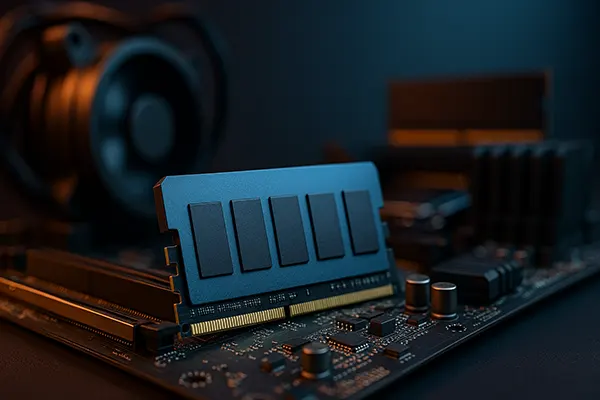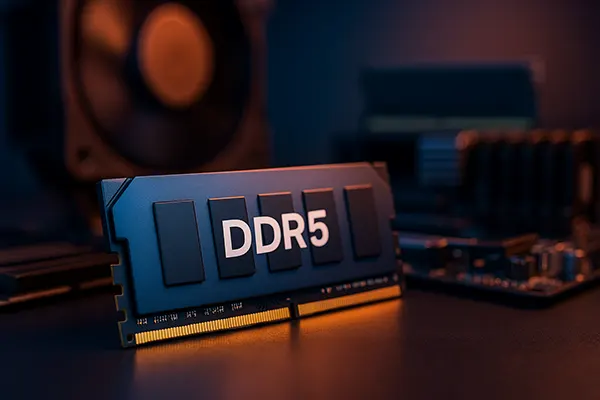
How DDR5 Is Changing PC Performance in 2025: Benchmarks, Compatibility, Prices
As the computing world moves further into 2025, DDR5 memory has established itself as the new standard, significantly outperforming its predecessor, DDR4. Whether it’s for gaming, professional software, or general productivity, DDR5 delivers noticeable benefits across the board. But how much of this change is actually measurable, and what does it mean for users considering an upgrade?
Real-World Benchmarks of DDR5 in 2025
DDR5 has reached widespread adoption among mainstream users and enthusiasts alike. Benchmarks from early 2025 reveal that DDR5-6000 and above now deliver up to 40% better memory bandwidth compared to DDR4-3200. These gains are particularly significant in multitasking environments, where the memory controller and CPU benefit from faster data access.
Gaming performance also benefits, especially in CPU-bound titles like “Cities: Skylines II” or “Microsoft Flight Simulator 2024.” Tests with Intel’s 14th-gen and AMD’s Ryzen 8000 series CPUs show framerate boosts of up to 15% in some scenarios, largely due to lower latency and higher throughput. However, the impact varies depending on GPU and resolution settings.
In creative and professional workloads, such as video editing in DaVinci Resolve or 3D rendering in Blender, DDR5 allows for quicker previews and render times. These improvements stem not only from faster clock speeds but also from higher module capacities, with 32GB becoming the new entry-level standard for prosumer systems.
Comparing DDR5 to DDR4: Is the Upgrade Worth It?
Upgrading from DDR4 to DDR5 is more than just a numbers game. While DDR5 offers better theoretical performance, practical gains depend on the specific use case. For general tasks like browsing or office work, users may not feel a substantial difference. But in memory-intensive applications, DDR5 proves its worth with tangible speed advantages.
Another point to consider is the architecture of the platform. AMD’s AM5 and Intel’s LGA1700 chipsets are optimised for DDR5, and their BIOS updates in 2025 have further enhanced memory overclocking stability. This synergy ensures maximum output from the latest CPUs and paves the way for futureproof builds.
Although DDR4 remains viable for budget users, its end-of-life in terms of mainstream support is approaching. Newer motherboards rarely include DDR4 slots, and fewer firmware updates are being issued for older platforms. Users aiming for longevity should strongly consider transitioning to DDR5.
DDR5 Compatibility with Current Platforms
As of February 2025, DDR5 memory is fully supported by all major consumer platforms. Intel’s 14th Gen Raptor Lake Refresh and AMD’s Ryzen 8000 series both rely solely on DDR5, eliminating support for DDR4. This shift ensures optimised memory performance and streamlines motherboard configurations.
Motherboards based on Z790, B760, X670, and B650 chipsets all support DDR5 exclusively. Furthermore, support for higher frequencies such as DDR5-7200 and beyond has been stabilised, with many modules reaching these speeds with XMP or EXPO profiles enabled. Manufacturers have also enhanced QVL lists to reduce compatibility issues.
Laptop manufacturers have followed suit. Premium and mid-range models now feature DDR5 SO-DIMMs as default, with capacities ranging from 32GB to 64GB. This transition marks a turning point, as DDR5’s efficiency and power savings now benefit both desktops and mobile systems alike.
What to Know Before You Upgrade
Upgrading to DDR5 requires a compatible motherboard and processor. Users still running Intel 12th or 13th-gen CPUs need to verify whether their boards support DDR5, as many models during those generations offered dual DDR4/DDR5 support. For AMD users, the shift to AM5 sockets eliminates backward compatibility with DDR4.
Another aspect to watch is BIOS compatibility. While most newer boards ship with updated firmware, older stock may need a BIOS flash before recognising DDR5 modules correctly. Users should also ensure they select memory modules listed on the motherboard manufacturer’s QVL to avoid stability issues.
DDR5 is more sensitive to voltage settings and temperature variations. It’s recommended to maintain proper airflow and monitor module temperatures during stress testing. Enthusiasts may explore manual tuning, but for most users, automatic XMP or EXPO settings provide the best mix of stability and performance.

DDR5 Pricing Trends and Availability
The cost of DDR5 has decreased steadily throughout 2024 and early 2025, thanks to expanded production from SK Hynix, Samsung, and Micron. As of February 2025, a 32GB DDR5-6000 CL36 kit retails for around £120, with higher-end kits priced between £180 and £220. These prices are now comparable to high-end DDR4 kits from previous years.
DDR5 availability has also improved. Local and online retailers regularly stock a wide variety of kits from brands such as Corsair, Kingston, G.Skill, and Crucial. The demand from both PC builders and OEM partners has pushed suppliers to offer more SKUs, including RGB models and low-profile variants.
Entry-level kits now start at around £80 for 16GB (2x8GB) configurations, making DDR5 accessible even for budget-conscious builders. Promotional bundles from motherboard manufacturers often include DDR5 kits at a discount, further reducing the cost barrier for first-time adopters.
Future Outlook and Market Predictions
With DDR6 development underway but commercial rollout expected no earlier than late 2027, DDR5 will remain the dominant standard for several years. Industry analysts predict further price reductions and improved module efficiency throughout 2025 and 2026.
Additionally, the rise of AI and large language model workloads on consumer-grade hardware is likely to accelerate demand for higher memory capacity. DDR5’s scalability makes it an ideal fit for these tasks, offering better bandwidth for inference and training at the desktop level.
By late 2025, we may see the emergence of DDR5-8000+ kits with native support from upcoming Intel Lunar Lake CPUs and AMD Zen 5 Refresh chips. These advances will push memory performance to new heights and continue to shape the evolution of computing in the years ahead.



